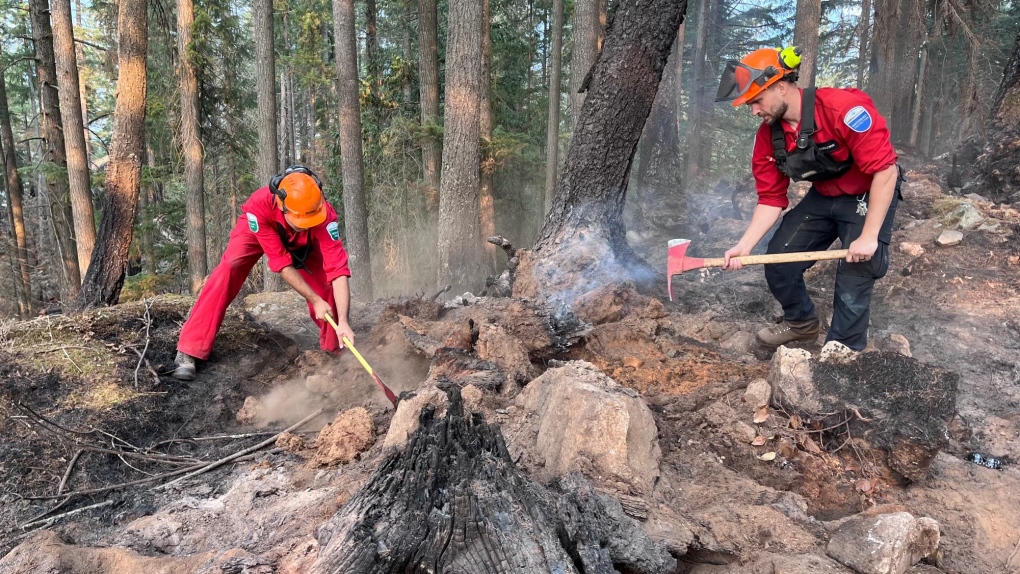Fire crews delay plans to use thermal camera at Minnekhada Park until rain falls
 Photos posted to MVRD's Twitter on Oct. 18, 2022, show emergency crews using various methods to battle a wildfire in Minnekhada Park.
Photos posted to MVRD's Twitter on Oct. 18, 2022, show emergency crews using various methods to battle a wildfire in Minnekhada Park.
Fire crews in Coquitlam are waiting for the rain before proceeding with plans to use a thermal heat scan at Minnekhada Regional Park, which has been closed since a wildfire broke out on Oct. 1.
While the flames are under control, the Metro Vancouver Regional District says the decision to delay thermal scanning, which was set to happen on Monday, is based on changing weather patterns and operational priorities.
“Our ground patrols have been extremely effective at locating and extinguishing hot spots,” explains Brant Arnold-Smith, the region’s emergency operations centre director.
The purpose of using thermal cameras while battling fires, according to Arnold-Smith, is to help crews identify and map hotspots that would be otherwise unreachable or untraceable. Drones are outfitted with the camera, which then examines surface temperatures from the air.
“In some instances, there may be no sign of smoke, fire, or other indicators,” Arnold-Smith says. “A thermal scan can…allows crews to quickly respond to hot spots that have the potential to burn hidden underground and reignite.”
More than two weeks after the fire was deemed “under control,” triggering a multi-jurisdiction response, only MVRD emergency personnel remain on site. Fully-extinguishing the flames has been a difficult feat due to steep, challenging terrain at the park, as well as unseasonably warm weather conditions.
On Twitter this week, MVRD posted a thread detailing the different angles crews have been taking to tackle the fire. With the help of helicopters, emergency personnel have been able to transfer thousands of gallons of water per hour from the Pitt River on to the fire, according to the tweet.
Crews have also been utilizing the park’s natural firefighting tools, like trails that block the path of quick-spreading flames. In addition, the efforts have included the use of handheld tools for chopping and digging, and hoses designed to be carried long distances over steep and rough terrain.
Arnold-Smith says his team knows there’s a lot of public interest in the park’s status, which is why updates are being regularly posted online.
“We are incredibly proud of the work that our crews have done,” says Arnold-Smith. “We hope to keep the public informed of the work crews are doing while increasing awareness of the efforts and resources required to battle a wildfire.”
CTVNews.ca Top Stories

Ontario Premier Doug Ford threatens to cut off energy to U.S. in response to Trump's tariffs
Ontario Premier Doug Ford has threatened to cut off energy supply to the U.S. in response to the tariffs President-elect Donald Trump plans to impose on all Canadian imports.
Elon Musk calls Justin Trudeau 'insufferable tool' in new social media post
Billionaire Elon Musk is calling Prime Minister Justin Trudeau 'an insufferable tool' in a new social media post on Wednesday. 'Won't be in power for much longer,' Musk also wrote about the prime minister on 'X.'
Sask. hockey coach convicted of historic sex crime back on day parole after 'behavioural concerns'
A former WHL coach found guilty last year of sexually assaulting a teen boy is back on day parole.
The Body Shop Canada to be sold to Serruya Private Equity
The Body Shop Canada is due to be sold to a company led by the co-founder of frozen yogurt chain Yogen Früz.
Trudeau will have to 'kiss the ring' to achieve smoother bilateral relations with Trump: John Bolton
If Prime Minister Justin Trudeau wants to get on U.S. president-elect Donald Trump's good side for the sake of a smooth bilateral relationship, he'll likely have to be openly deferential, says former U.S. National Security Advisor, John Bolton.
Luxury real estate brokers charged in federal indictment with sex trafficking in NYC
Two luxury real estate brokers and their brother have been charged with luring, drugging and violently raping dozens of women over more than a decade.
Alberta family doctor suspended for unprofessional conduct
An Alberta family doctor and veterinarian has been suspended for unprofessional conduct.
Police locate labyrinth of tunnels connecting tents to generator in Hamilton encampment
Hamilton police say that they discovered a series of 'man-made holes and tunnels' during a patrol of a downtown encampment earlier this week.
Certain foods may disrupt your body's fight against cancer cells, study says
The food you eat may be affecting your body’s ability to fight cancer cells in the colon, according to a new study.

































